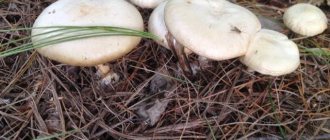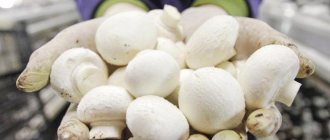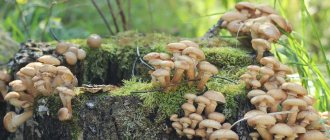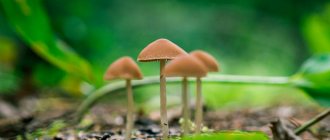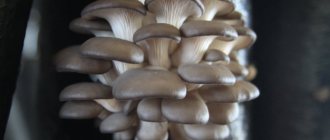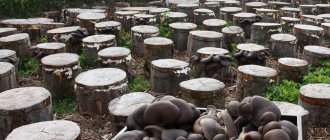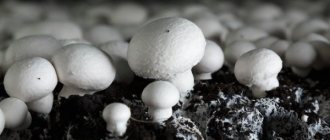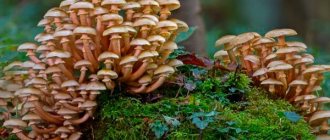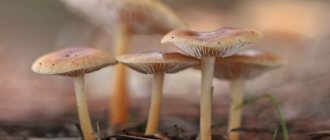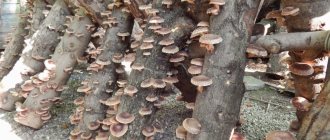Honey mushrooms are considered unpretentious mushrooms and grow well on almost any wood, but for successful cultivation you need to know some cultivation features. Growing honey mushrooms at home will not only help you obtain high-quality mushrooms, but can also turn into a profitable business.
The rules, methods and possible difficulties of growing honey mushrooms are described in this article. You will learn how to properly cultivate different types of mushrooms on stumps and at home.
- Peculiarities
- Peculiarities
How to grow honey mushrooms at home
Honey mushrooms are considered one of the most popular types of mushrooms, suitable for growing at home. Their attractiveness lies not only in their excellent taste, but also in their fast growth rate, which allows them to obtain high yields in a small area. This article will tell you how to organize your own mushroom garden.
Among all types of honey mushrooms, the most suitable for cultivation in artificial conditions are winter and summer. The first of them is valued not only for its good taste, but also for its medicinal properties, because this mushroom contains substances that increase the body's resistance to cancer. As you know, only the cap of forest mushrooms is taken for cooking, since the stem is too hard. But in domestic mushrooms, both the cap and the stem are successfully used for food.
Growing conditions
Winter species can be grown both in an apartment and in the basement, as well as in a greenhouse or simply in a summer cottage or garden. The main thing is to provide the proper conditions under which the mycelium will grow and reproduce (Figure 1):
- Constant temperature ranging from 10 to 15 degrees above zero.
- High air humidity (70%-80%).
- Proper level of lighting.
- Heating the room in which mushrooms are grown in the cold season and cooling it in the summer.
- Well-established ventilation.
Figure 1. Options for growing at home
It is also necessary to ensure optimal phytosanitary standards so that the mushrooms are not exposed to pests and diseases.
Growing methods
Growing honey mushrooms at home for beginners can be done in several ways (Figure 2):
- On stumps (cut down logs);
- In banks;
- In the greenhouse.
Let's consider the technology features of each method. The most minimal cost method is the method of growing on stumps. The essence of this method is that mushroom mycelium is introduced into small (1-2 cm) holes made in the wood, which are covered with moss.
Note: If the mycelium has been colonized in growing stumps, then the soil around them must be periodically watered. If felled logs are used as “containers,” then they must first be soaked in water for several days and only after that the mycelium should be populated.
To stimulate the growth of mycelium, the logs are placed in a basement with a constant temperature (+15-20 C) and covered with straw. Since when growing mushrooms it is necessary to maintain a high level of humidity, it is recommended to wipe the floors and walls of the room in which the logs are located at least once a day. As soon as they are overgrown with mycelium, they must be taken out to the site and buried. The very next year you will be able to get the first harvest of honey mushrooms, and the mushrooms will bear fruit until the stump (log) falls apart.
If there is no actual plot, then there is a way to grow in jars in an apartment. The main task here is to properly prepare the nutrient substrate.
You will need small sawdust (seed husks) and the same small shavings in a 2:1 ratio. This sawdust-shaving mixture must be boiled in water, then allowed to drain. After cooling, nutrients are added to the resulting slurry: starch, oatmeal and corn flour at the rate of 8 g of starch and 25 g of each of the two types of flour per 1 kg of sawdust.
Figure 2. Home growing methods: in a jar, on stumps and in a greenhouse
The resulting substrate is placed in jars (1-3 liters) to two-thirds of the volume and compacted. Then the containers with the nutrient substrate are sterilized for 2 hours, and after it cools to room temperature, the mycelium is introduced into a hole 5-7 cm deep. Containers with mycelium are stored in a dark, humid room at a constant temperature of +24, and after the mycelium germinates, they are transferred to a cooler place or the temperature is reduced to +14+16. To make harvesting easier, a paper cuff is placed around the neck of the jar.
Owners of greenhouse structures can use the method of growing in a greenhouse. To do this, you will need special substrate blocks, which you can purchase or make yourself. Each such block consists of sawdust from deciduous trees (except oak), oats (barley) and chalk (lime groats). 200 g of dry sawdust are boiled in 2 liters of water for 2 hours. After the gruel has cooled to +25, add the remaining components: 70 g of oats (or its substitute) and 1 tsp. chalk. All ingredients are mixed and placed in bags. Then 20 g of mycelium is added to each such bag (block), gently kneading it.
Before you tie the bag, you need to put a stopper made of sterile cotton wool so that the substrate inside does not dry out. The blocks are stored in a room with a constant temperature of +20 degrees. When tubercles appear on the surface of the substrate (this happens within 30 days), the bag is removed and the room temperature is lowered to +12+14 degrees. In this case, you should maintain high humidity in the greenhouse (85%) and regularly ventilate the room.
Growing technology
The technology of growing in the country and in the garden depends not only on the method in which they will be grown, but also on the method of obtaining raw materials for propagation.
The most popular technologies for obtaining planting material are considered:
- The fruiting body of the mushroom: for this it is necessary to select the caps of overripe mushrooms, the reverse side of which is painted dark brown, and the diameter of the cap itself is at least 8 cm. The selected caps are kept in water for a day, then, without removing them from the aquatic environment, knead until obtaining a slurry, which is filtered through several layers of gauze. Stumps (logs) are watered with the resulting mash from the spores. The wood must first be prepared by making small depressions in it, into which the liquid will fall. After the stumps are settled, all recesses are covered with damp sawdust or moss, and the ends of the stumps remain open.
- From mycelium: this method is used mainly in the fall. A piece of the stump on which the mycelium grew in the forest is divided into small pieces measuring 2x2 cm. These pieces of grafting wood are placed in holes previously made on the sides of the stump intended for growing. After this, the recesses are covered with sawdust or moss, and the end of the stump is covered with a thick plastic film, which will help maintain the desired level of humidity inside the stump. With the onset of cold weather, the stumps are additionally covered with spruce paws. In the spring, it is necessary to ensure that when the snow melts, water does not fall on the ends of the stumps, since it can cause significant harm to the mycelium developing inside them. For this reason, it is necessary to regularly shake off snow from spruce branches so that in case of a thaw, the infected stump is not damaged. The branches can be completely removed immediately before fruiting begins, that is, at the end of July, if we are talking about autumn honey mushrooms.
Remember that this type of fungus is a parasite, and therefore settles not only on dead wood, but also on living trees, shrubs and even herbaceous plants. Therefore, when growing autumn honey mushrooms on your site, take precautionary measures to prevent fungal spores from infecting fruit-bearing crops. To do this, a stump infected with fungal mycelium must be dug into a ditch 30 cm deep and 10 cm wide at a distance of 2 m.
Honey mushrooms are also well suited for growing indoors, where the required level of humidity is always maintained. That is why greenhouse growing technology is so widely used. It involves the colonization of half-rotten logs or stumps in bags with a spore chatter. Infected logs remain in the greenhouse until the mushrooms germinate. At the same time, they must be periodically subjected to the sprinkling procedure. It is best to irrigate every hour, starting from 12 to 5 o'clock in the afternoon. The duration of the procedure is 5 minutes. If this technology is followed, the first harvest can be harvested in mid-June.
How to grow honey mushrooms step by step at home
Honey mushrooms are so popular among mushroom lovers that a method was invented for growing them not just at home, but in an apartment, even if it is located in a multi-story building. You will be able to harvest homemade honey mushrooms only after a month and a half from the moment the mycelium is added to the substrate. At the same time, in one jar with a capacity of 3 liters, you can grow up to one and a half kilograms of mushrooms. The only drawback of this method is that only winter honey mushrooms can be grown this way, the size of which is ideal for growing on a windowsill (Figure 3).
So, step-by-step instructions will tell you how to grow honey mushrooms in a country house or in an apartment:
- Prepare a nutrient substrate from bran and sawdust from deciduous trees in a ratio of 1:3.
- Soak the resulting mixture in water for a day, then squeeze it out and put it in three-liter jars, filling them halfway.
- Make indentations in the substrate that reach the bottom using a thin long stick.
- Sterilize the jars with the substrate over low heat for an hour. After the jars have cooled, repeat the procedure again. This procedure will kill all pathogenic microorganisms inside the containers and prevent mold from developing.
- After the second boil, allow the jars to cool to room temperature, then cover them with plastic lids with holes up to 2 mm in diameter.
- Introduce the mycelium through the holes made using a medical syringe.
- Jars populated with mycelium must be kept in a room with a constant ambient temperature (not lower than +20) for about 30 days.
- As soon as the mushrooms germinate, you need to move the jar to a cooler place. This could be, for example, a window sill located on the north side, or a balcony, provided that the air temperature there does not drop below +13.
- After the honey mushrooms reach the neck of the jar, the lid is removed, and a paper cuff is placed on the neck of the vessel, which will limit the area where the mushrooms grow.
- To maintain optimal humidity levels, periodically mist the mushroom caps.
Figure 3. Features of growing honey mushrooms in a jar
By following the above rules, you will be able to harvest the first harvest of winter mushrooms 2 weeks after germination. The mushrooms can be cut off, or you can simply pull them out, because in a few weeks a new wave of honey mushrooms will appear.
The video shows how to properly sow honey mushroom mycelium when growing mushrooms in a jar.
Growing difficulties
The main difficulty in growing honey mushrooms is that their spores spread quickly and can settle not only on rotten stumps, but also on healthy wood.
To prevent this from happening, you need to be very careful about the procedure for sowing the mycelium and cultivating mushrooms only in specially designated rooms. In addition, honey mushrooms are very sensitive to temperature and humidity conditions, so at all stages of cultivation it is necessary to maintain certain indicators.
How to grow honey mushrooms in the country
To grow winter mushrooms in the country, you will need a greenhouse or any basement in which you can provide a constant high level of humidity. In addition, you will need to purchase a special nutrient substrate for growing mushrooms or prepare it yourself, as well as stock up on granulated mushroom mycelium.
Let us describe in more detail the features of growing on a summer cottage.
Peculiarities
The mixture for growing mushrooms can be easily prepared on your own using dry sawdust (200 g), oats (70 g) and unslaked lime (1 tsp). All of the listed components are mixed, then soaked for 5 minutes, then cooked for another 45 minutes. After this, the water must be drained and the resulting mixture dried for 20 minutes over low heat.
The finished substrate is cooled to a temperature of +25 degrees, then laid out in prepared containers (jars, bags). 20 g of mycelium are poured into the same containers, the containers are hermetically sealed, after inserting a stopper made of sterile cotton wool. In this state, the substrate with mycelium is stored at a temperature of +15+20 degrees for a month. After the mycelium germinates, the packages are transferred to the material where fruiting will occur.
How to grow honey mushrooms in the country from mycelium
Summer honey mushrooms can be grown on a summer cottage from mycelium. The optimal substrate for their cultivation is old stumps of deciduous trees such as maple, birch, aspen or damp boards or trimmings of logs (Figure 4). Moreover, they are much easier to grow than champignons or oyster mushrooms.
Peculiarities
It is important to know that when growing honey mushrooms on stumps that are located on the territory of the garden plot, there is a risk of infection with mycelium of fruit trees, which leads to the destruction of their wood and, as a consequence, to the death of the tree itself.
Therefore, try to choose those stumps that are far from living plants, or grow mushrooms indoors.
Methods
In early May, when the optimum level of humidity and temperature is observed, it is necessary to irrigate the surface of the stump with seed mycelium. It is recommended to first make small depressions in the hemp to better fill it with mycelium. After populating the holes, they must be sealed with moss. Experienced mushroom pickers also practice breeding summer honey fungus by grafting small pieces of wood infected with mycelium. They are inserted into pre-prepared holes on the surface of the hemp.
Figure 4. Preparation of mycelium for growing honey mushrooms
No matter how the mycelium settles into the stump, they must be covered with a thick film to create an optimal microclimate for the rapid development of the mycelium. One such mycelium allows you to harvest honey mushrooms for 3-6 years, while the first time you can pick mushrooms a year after introducing the spores.
You can also infect fungal spores in scraps of logs or even damp boards. To do this, add fungal spores to a bottle of water, shake thoroughly and pour this solution over the growing material. It is desirable that the material has more cracks in which the fungal mycelium can settle. Subsequent care consists of regularly irrigating the wood to maintain the required level of humidity.
Greenhouse mushroom farming
If harvesting outdoors depends on weather conditions, in a greenhouse the process will be more stable, because there is always optimal humidity and temperature conditions.
- In the corner of the greenhouse, logs, saw cuts or large pieces of wood are stacked in a low pile.
- Everything is watered with a chatter of spores, or mycelium is planted, as when growing on stumps.
- Everything is carefully watered periodically with rain or well water.
- In the greenhouse, crops can be harvested from May to September.
The solution contaminated with spores is generously watered on the moistened stumps, after first making shallow cuts-cuts on their vertical surfaces with a sharp knife (about 10-12 pieces per stump in random order). The solution will take about a liter for each stump. After replanting the spores, the recesses are filled with wet sawdust, and the upper part of the stump remains open.
Let's work together to make the unique material even better, and after reading it, we ask you to repost it on a social network convenient for you. net.
Growing honey mushrooms at home on stumps
In your own garden or at your summer cottage, you can grow honey mushrooms on the stumps of deciduous trees: birch, poplar, aspen, apple, and pear. The main thing is that the stump chosen for propagation is not affected by rot or tinder fungi. 2-3 days before the introduction of mycelium, it is necessary to periodically moisten the stumps with water.
You can use both purchased mycelium and independently collected forest material. To do this, you will need 10-12 mushroom caps, which you need to fill with a bucket of rain (river, lake) water and leave for a day.
Note: It is important to know that water from stagnant bodies of water (pond, quarry, ravine) is not suitable for these purposes, as it may be contaminated with pathogens.
The soaked caps are kneaded by hand into a paste, which is filtered through several layers of gauze. The resulting spore solution is poured over the end and side parts of the selected and prepared stump. To increase the likelihood of a stump becoming infected with mycelium, it is recommended to make small holes with a diameter of 2 cm in the wood at a distance of 4 cm from each other. It will be much more convenient if the holes made are staggered. These depressions are additionally filled with spore porridge and covered with moss or sawdust. In this case, the end of the hemp is left open. By growing mushrooms in this way, you can get your first harvest of honey mushrooms in 2 years (Figure 5).
You need to know that the mycelium of the fungus can infect other healthy trees located in the immediate vicinity of the infested stump. Therefore, it is necessary to take protective measures by digging around the infected stump with a ditch 30 cm deep and 10-15 cm wide at a distance of 2 m around it.
Figure 5. Features of growing honey mushrooms on stumps
Breeding honey mushrooms can also be done using wood sticks infected with mycelium, which are inserted into prepared holes on the stumps. This procedure is carried out in April-May, when the sun is already quite active and can dry out the mycelium. Therefore, it is recommended to cover the infested stump with a layer of straw or dry grass. For the winter, the stump must be covered with spruce branches. In snowy weather, regularly shake off the snow accumulated on the branches, and with the arrival of spring, make sure that melt water does not get on the end of the stump, since this greatly inhibits the development of the mycelium, which means that you will get the harvest much later.
Seed material and technology for its production
Honey mushrooms are grown in two ways (depending on the seed): either a fruiting body, i.e. old mushrooms or mycelium.
The first technology step by step:
- remove the caps (usually they have a circumference of about 8 cm, with a dark brown tone on the inside);
- the material is placed in a container with water and soaked for a day (without rinsing or straining);
- the caps are crushed to a pulp;
- the result is passed through gauze;
- the liquid is poured into a glass vessel and used for sowing;
- grooves are made in the wood of a stump or log, and the resulting slurry is poured into them;
- The grooves are covered with sawdust.
The planting method from such seed material is used at any time of the year in a closed building.
Mycelium is a mycelium from which honey mushrooms, champignons and other mushrooms are grown. You can find it in the forest in the fall:
- the mycelium is divided into pieces 2*2 cm;
- holes are made on the sides of the hemp;
- pieces of mycelium are placed in slots and covered with moss;
- the holes are wrapped with polyethylene on top to create greenhouse conditions;
- when frost sets in, the mycelium is covered with coniferous branches;
- if the planting stump is located in an open area, it is protected from excess moisture: it is cleared of snow mounds;
- spruce spruce branches, polyethylene and moss are removed in June for summer ones, and at the end of September for winter ones.
The advantage of growing from such material: it can be kept outdoors.
Winter honey fungus: growing at home
Among the edible species, winter ones are the easiest to grow at home (Figure 6). Their small size allows them to be grown even in a three-liter jar on the windowsill. Various materials are used as a growing substrate: straw, buckwheat husks, sunflower husks, dry sawdust from deciduous trees. To give the substrate the necessary fertility, various additives are mixed into it, for example, bran, brewer's grain, and corn cobs.
Then this nutrient medium is kept in water for a day and squeezed out. Glass jars are filled with the prepared substrate to half their volume and closed with lids with holes made with a diameter of 2 cm. For these purposes, you can also use cotton-gauze stoppers. The sealed jars are pasteurized for one and a half to two hours over low heat several times, waiting for the jars to cool.
Figure 6. Methods for growing winter mushrooms at home
After the last pasteurization, when the jars with the substrate have cooled to +24 degrees, begin planting mushrooms. To do this, with clean hands, place pre-crushed pieces of mycelium planting material into each jar. Closed jars are stored in a room with a temperature of +20+24 degrees until the mycelium germinates. After the mushrooms germinate, the jar is placed in a cooler place: on a windowsill, loggia, facing north. When the mushroom caps reach the neck of the jar, you need to put a paper cuff 5-10 cm high on it so that the mushrooms grow upward in the form of a bouquet. At this stage, it is very important to ensure high air humidity, so it is necessary to spray the mushroom caps with water and moisten the cuffs. After the mushrooms have completely emerged from the jar, they must be cut off, the jar closed again and taken to a warm place. In a week or two, the second batch of mushrooms will ripen.
Description
Honey fungus is an edible mushroom that grows in coniferous and deciduous forests. This species is pleasant to collect because it grows in large groups.
Distinctive external features:
- long and thin leg (12-15 centimeters);
- color – dark brown;
- The cap of a young specimen is covered with scales and becomes smooth with age.
Useful properties of honey mushrooms
Product benefits:
- low calorie level;
- the presence of thiamine (responsible for the human nervous system);
- providing antiviral and anticancer effects;
- removal of waste and toxins from the body;
- preventing heart disease.
Growing in nature
Most often, honey mushrooms can be found on a stump in the form of a whole family. Also found in meadows, forest edges and under bushes.
Poplar honey fungus: cultivation
Poplar honey fungus is highly prized for its pleasant nutty flavor and crunchy texture, along with porcini mushroom and truffle. The main disadvantage of this mushroom is its short shelf life: in its raw form, poplar honey mushrooms are stored for about 20 hours, and in frozen form - no more than 6 days. For this reason, they cannot be purchased online. But poplar honey fungus can be easily grown at home, just in a flower pot (Figure 7).
First of all, you will need a damp poplar or maple log taken from a healthy tree, free of branches. The height of the log should be about 30 cm, and its diameter should be 15 cm. It is necessary to make (drill) 2-3 holes in it with a diameter corresponding to the diameter of the sticks with mycelium. With clean hands, sticks with mycelium are inserted into the holes made, then they are sealed with wax, and the log is tightly wrapped in polyethylene, making several holes for ventilation. This kind of “container” with mycelium is stored in a dark and humid room until the mycelium germinates (3-4 months). This can be determined by the white threads of mycelium clearly visible in the holes. After this, the logs are placed vertically in flower pots measuring 70x15x15 cm, filled with earth (mulch, poplar sawdust). In this case, you should deepen the logs into the pot by 8-10 cm. This way you can get 2-3 harvests of honey mushrooms per year, and the mycelium will grow within 5-6 years.
Figure 7. Features of growing poplar honey mushrooms at home
You can also grow poplar honey mushrooms in your own garden or vegetable garden. A piece of loose, fertile land close to trees is ideal. In the spring, a 10-12 cm depression is dug in this area, corrugated cardboard is placed at the bottom, followed by a centimeter layer of sawdust. All this must be shed with water, and when it is absorbed, the mycelium on the substrate is laid on the sawdust. The mycelium is covered with a layer of sawdust mulch or wood chips and watered again. Level the edge of the depression to the general level of the site using a lightly mulched layer of soil. To prevent the substrate in the hole from drying out, it must be additionally covered with straw or tree bark and watered abundantly again. Subsequent care consists of maintaining the level of soil moisture, watering it when it dries out at a depth of 3-4 cm.
During fruiting of poplar mushrooms, it is recommended to collect mature mushrooms every day so that the mycelium does not get sick, and in the cold season, take care of additional shelter for it.
Similar species
Several varieties of honey mushrooms grow in nature, but only two can grow under artificial conditions without loss of taste:
- summer;
- winter (so-called flammulina).
The winter look itself attracts with its delicate, unique taste.
They are consumed fresh or dried, and both caps and stems are used for processing (unlike wild relatives). Flammulina caps are reddish-yellow in color and grow up to 9 cm in diameter. The pulp is yellowish, with a pleasant mushroom taste. Under natural conditions, mushrooms ripen in the fall and can last until December, and with frequent thaws - until February .
Important! Winter mushrooms contain mild toxic substances that are destroyed 20 minutes after cooking.
The summer variety is slightly smaller - the cap is up to 6 cm. Their flesh is watery, and the taste is mild, not pronounced. Mushroom pickers claim that they can be eaten raw, simply picked from a stump. In its natural environment, this species grows in colonies on rotten wood.
If the climate is mild, then such mushrooms can be collected all year round.
A rare species is poplar honey fungus . The place of growth can be not only a poplar stump, but also a maple log. This variety is distinguished by its nutty flavor and crumbly structure.
But poplar honey fungus has a big drawback: it can be stored for no more than a day, and in frozen form - no longer than a week.
Perhaps the rarest form is the marbled honey fungus . Such mushrooms are considered delicacies. They taste sweet, nutty, and crunchy. This variety is also valued for its lack of fat and high concentration of nutrients. Stored in the cold for no longer than 1–1.5 weeks.
Any housewife, even a beginner, knows that mushrooms need to be soaked in water. But not marble ones - they absorb moisture and become fragile.
Marbled honey fungus: growing at home
Marbled honey fungus is a delicious mushroom. When cooked, it has a sweet smell, a pleasant nutty flavor and a slightly crunchy texture. In their raw form, this type of mushroom can be stored in a cold place for up to 10 days.
Note: The difference between marbled honey mushrooms and all others is the fact that this type cannot be soaked in water, because when they gain moisture, they become brittle. In addition, marble honey fungus contains a large amount of nutrients, with a complete absence of fat, which makes it possible to use dishes from it in diets aimed at weight loss to stabilize metabolism. There is a known positive effect in the treatment of anemia, asthma, diabetes, cardiovascular system organs and many other diseases using marble honey mushrooms.
To grow marble mushrooms, a substrate is used, consisting of cotton waste (85%), rice or wheat bran (10%), sugar and gypsum powder (1 each), and lime (3%). Cotton waste is filled with water with lime dissolved in it. The resulting mixture is wrapped in film for a day, then rice bran and gypsum are added to it, the acidity level is checked (it should be 6.5 - 7.5 pH).
The compost is placed in plastic bags or wide-necked jars, hermetically sealed and sterilized for 3 hours. The mycelium is inoculated into the sterile substrate, the packages are transferred to a storage room in which the air temperature is +18+26 degrees. After 40 days, the mycelium germinates and matures for another 30 days. Bags with mature mycelium are placed on special racks in a cool room (+13+15). They must be opened, the substrate moistened, and the bags covered with damp paper or cloth. After the mushroom caps appear, the damp cloth must be removed, further maintaining the necessary humidity by spraying the air at the same temperature. At the same time, it is necessary to ensure the proper level of lighting in the room. If mushrooms are grown without sun, they must be illuminated with a fluorescent lamp for 10-15 hours.
Harvesting involves gently cutting off the mushroom clusters while pressing down on the substrate around the root with your other hand. For the next mushroom wave, you need to clean the substrate from the stems of dead mushrooms and add water to it. In 2 weeks a new harvest will appear. In total, one such bag (package) gives 4-5 harvests of marble mushrooms.
Edibility
Poplar honey fungus is not only edible, it is also extremely tasty. Its pulp is characterized by an unusual, crispy texture. The agrocybe mushroom is eaten in the southern regions of France, where it is considered one of the best mushrooms and is included in the Mediterranean menu. Poplar honey fungus is also popular in Southern Europe. This mushroom can be pickled, frozen, dried, or canned.
Agrocybe makes very tasty soups, sauces for a variety of sausages and pork meat. Agrocibe is very tasty in combination with hot, freshly cooked corn porridge. Fresh and unprocessed mushrooms can be stored in the refrigerator for no more than 7-9 days. Honey mushrooms are a generally accepted non-systematic name for a group of mushrooms that belong to different families and genera, but are united by similar appearance features and typical habitats - most often on diseased or dead wood.
